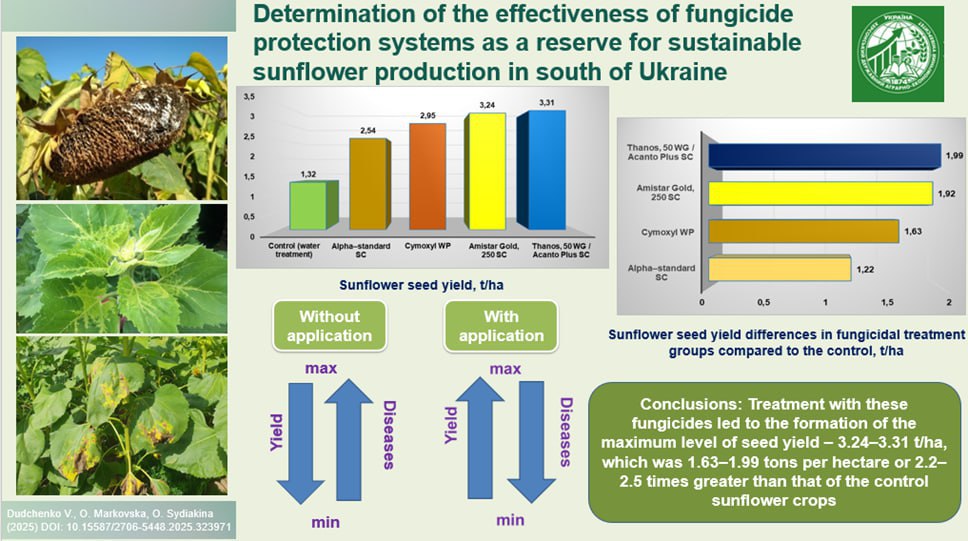Визначення ефективності систем фунгіцидного захисту як резерву сталого виробництва соняшнику на півдні україни
DOI:
https://doi.org/10.15587/2706-5448.2025.323971Ключові слова:
біла гниль, фомоз, фомопсис, пероноспороз, розвиток хвороби, фунгіцидний захист, соняшник, урожайністьАнотація
Соняшник є стратегічною культурою в аграрному секторі України, але врожайність і якість його насіння значно знижуються через ураження фітопатогенами. Одним із основних методів їх контролю є застосування фунгіцидів. Дослідженням, проведеним в умовах півдня України, було встановлено вплив схем застосування фунгіцидів на основі діючих речовин з класів бензимідазолів, стробілуринів, триазолів на поширення та шкідливість домінуючих хвороб і врожай соняшнику. Основними хворобами культури були біла гниль, пероноспороз, фомоз, фомопсис. За відсутності фунгіцидного захисту розвиток хвороб у фазі BBCH 91 був значним та досягнув 17,5 % (біла гниль), 28,9 % (пероноспороз), 15,3 та 14,5 % – фомоз й фомопсис, відповідно. Найкращі показники біологічної ефективності для контролю Sclerotinia sclerotiorum та Phoma macdonaldii у фазі BBCH 16 мав Амістар Голд, 250 КС (1,0 л/га) – 78,0 та 84,3 %, відповідно. Проти Diaporthe helianthi й Plasmopara halstedii найвищу ефективність у цю ж фазу застосування мав Танос, 50 ВГ – 86,6 та 92,7 %, відповідно. Використання Амістар Голд, 250 КС та Аканто Плюс КС у фазі BBCH 51 показало високу біологічну ефективність проти фомозу й фомопсису, яка знаходилась у межах 88,8–90,3 %. Проти пероноспорозу ефективність Аканто Плюс КС була вищою на 4,5 %, порівняно з Амістар Голд, 250 КС, й становила 88,9 %. Проти білої гнилі ефективність цих препаратів була в межах 80,0–85,7 % з переважанням Аканто Плюс КС. Альфа-стандарт КС не впливав на розвиток пероноспорозу та характеризувався низькою ефективністю проти білої гнилі – 17,1 %. Проти фомозу й фомопсису він мав середні показники ефективності – 74,5; 77,2 %, відповідно. Використання схем застосування фунгіцидів: Амістар Голд, 250 КС (ВВСН 16; 51) й Танос, 50 ВГ (ВВСН 16) та Аканто Плюс КС (ВВСН 51) забезпечило максимальну врожайність – 3,24; 3,31 т/га, що перевищувало контроль на 1,63; 1,99 т/га, відповідно. Рекомендовані схеми захисту з використанням Амістар Голд, 250 КС (1,0 л/га), Танос, 50 ВГ (0,6 кг/га) та Аканто Плюс КС (1,0 л/га) можуть бути впроваджені в господарствах півдня України та адаптовані до інших зон вирощування соняшнику.
Посилання
- Pinkovskyi, H., Tanchyk, S. (2020). Productivity and economic efficiency of growing sunflower depending on the sowing time and plant density in the Right-Bank Steppe of Ukraine. Agrobìologìâ, 2 (161), 115–123. https://doi.org/10.33245/2310-9270-2020-161-2-115-123
- Chuiko, D. V., Ponomarova, M. S., Brahin, O. M. (2021). Economic efficiency of growing lines, hybrids and varieties of sunflower dependent from the plant growth regulator. Visnyk KhNAU. Seriia: Ekonomichni nauky, 1 (2), 197–208.
- Shyshkin, V., Onyshchenko, O. (2020). Present state and prospects of agricultural development of Ukraine. Management and Entrepreneurship: Trends of Development, 3 (13), 72–86. https://doi.org/10.26661/2522-1566/2020-3/13-06
- Trojanová, Z., Sedlářová, M., Gulya, T. J., Lebeda, A. (2016). Methodology of virulence screening and race characterization of Plasmopara halstedii, and resistance evaluation in sunflower – a review. Plant Pathology, 66 (2), 171–185. Portico. https://doi.org/10.1111/ppa.12593
- Sackston, W. E.; Spencer, D. E. (Ed.) (1981). Downy mildew of sunflower. The Downy Mildews. London: Academic Press, 545–575.
- Young, P. A., Morris, H. E. (1927). Plasmopara downy mildew of cultivated sunflowers. American Journal of Botany, 14 (9), 551–552. https://doi.org/10.1002/j.1537-2197.1927.tb04866.x
- Gulya, T. J, Miler, J. F., Viranyi, F., Sackston, W. E. (1991). Proposed internationally standardized method for race identification of Plasmopara halstedii. Helia, 14, 11–20.
- Mathew, F., Harveson, R., Block, C., Gulya, T., Ryley, M., Thompson, S., Markell, S. (2020). Sclerotinia Diseases of Sunflower. Plant Health Instructor, 23, 23–27. https://doi.org/10.1094/phi-i-2020-1201-01
- Harveson, R. M., Markell, S. G., Block, C. C., Gulya, T. J. (2016). Introduction. Compendium of Sunflower Diseases and Pests, 1–13. https://doi.org/10.1094/9780890545096.001
- Rashid, K. Y., Block, C. C., Gulya, T. J. (2016). Sclerotinia Head Rot and Midstalk Rot. Compendium of sunflower diseases and pests. St. Paul: American Phytopathological Society Press, 51–55.
- Pikovskyi, M. Y., Kyryk, M. M. (2021). Bioekolohichni osoblyvosti fitopatohennykh hrybiv Sclerotinia sclerotiorum (Lib.) de Bary i Botryotinia fuckeliana (de Bary) Whetzel. Kyiv: FOP Yamchynskyi O.V., 278.
- Holley, R. C., Nelson, B. D. (1986). Effect of Plant Population and Inoculum Density on Incidence of Sclerotinia Wilt of Sunflower. Phytopathology, 76 (1), 71–74. https://doi.org/10.1094/phyto-76-71
- Quiroz, F. J., Edwards Molina, J. P., Dosio, G. A. A. (2014). Black stem by Phoma macdonaldii affected ecophysiological components that determine grain yield in sunflower (Helianthus annuus L.). Field Crops Research, 160, 31–40. https://doi.org/10.1016/j.fcr.2014.02.011
- Dedić, B. (2016). Phoma macdonaldii Boerema, prouzrokovač crne pegavosti stabla suncokreta – varijabilnost populacije i iznalaženje izvora otpornosti. [Doctoral dissertation; University of Novi Sad].
- Thompson, S. M., Tan, Y. P., McTaggart, A. R., Shivas, R. G. (2016). Subcommittee on Plant Health Diagnostics. National Diagnostic Protocol for Diaporthe helianthi – NDP40 V1. Eds. Subcommittee on Plant Health Diagnostics.
- Mathew, F., Block, C., Harveson, R., Gulya, T., Ryley, M., Thompson, S., Markell, S. (2019). Diaporthe helianthi (stem canker of sunflower). CABI Compendium. CABI Publishing. https://doi.org/10.1079/cabicompendium.18733
- Mathew, F., Harveson, R., Gulya, T., Thompson, S., Block, C., Markell, S. (2018). Phomopsis Stem Canker of Sunflower. Plant Health Instructor, 18 (1). https://doi.org/10.1094/phi-i-2018-1103-01
- Kareem, F. H., Matloob, A. A. (2020). Efficiency of some of bio–formulas against fungi caused sunflower root rot disease. International Journal of Agricultural and Statistical Sciences, 16 (1), 1485–1493. https://connectjournals.com/03899.2020.16.1485
- Moin, S., Ali, S. A., Hasan, K. A., Tariq, A., Sultana, V., Ara, J., Ehteshamul-Haque, S. (2020). Managing the root rot disease of sunflower with endophytic fluorescent Pseudomonas associated with healthy plants. Crop Protection, 130, 105066. https://doi.org/10.1016/j.cropro.2019.105066
- Pospelov, S. V., Pospielova, G. D., Nechiporenko, N. I., Mishchenko, O. V., Cherniak О. О., Skliar, S. S., Ivanichko, O. V. (2021). Analysis of sunflower areas’ phyto-pathogenic condition during vegetation period under different agro-climatic conditions. Scientific Progress & Innovations, 4, 133–141. https://doi.org/10.31210/visnyk2021.04.17
- Andriichuk, T., Skoreiko, A., Kuvshynov, O. (2021). Evaluation of phytosanitary condition of sunflower crops in the Western Forest-Steppe of Ukraine. Interdepartmental Thematic Scientific Collection of Plant Protection and Quarantine, 67, 73–84. https://doi.org/10.36495/1606-9773.2021.67.73-84
- Kgatle, M. G., Flett, B., Truter, M., Aveling, T. A. S. (2020). Control of Alternaria leaf blight caused by Alternaria alternata on sunflower using fungicides and Bacillus amyloliquefaciens. Crop Protection, 132, 105146. https://doi.org/10.1016/j.cropro.2020.105146
- Melnychuk, F. S., Marchenko, O. A., Vasyliev, A. A. (2020). The influence of irrigation on the phytopathogenic complex on sunflower under the conditions of the Forest-Steppe of Ukraine. Taurian Scientific Herald, 2 (116), 32–40. https://doi.org/10.32851/2226-0099.2020.116.2.5
- Trybel, S. O., Siharova, D. D., Sekun, M. P., Ivashchenko, O. O. et al. (2001). Metody vyprobuvannia ta zastosuvannia pestytsydiv. Kyiv: Svit, 448.
- Stankevych, S. V., Zabrodina, I. V., Vasylieva, Yu. V., Turenko, V. P., Kuleshov, A. V., Bilyk, M. O. (2020). Monitorynh shkidnykiv i khvorob silskohospodarskykh kultur. Kharkiv: FOP Brovin O. V., 624. Available at: https://repo.btu.kharkov.ua//handle/123456789/24118
- Ushkarenko, V. O., Nikishenko, V. L., Holoborodko, S. P., Kokovikhin, S. V. (2008). Dyspersiino-koreliatsiinyi analiz u silskomu hospodarstvi ta roslynnytstvi. Kherson: Ailant, 272.
- Bilai, V. I. (1982). Metody eksperymentalnoi mikolohii. Kyiv: Naukova dumka, 552.
- Abbott, W. S. (1925). A Method of Computing the Effectiveness of an Insecticide. Journal of Economic Entomology, 18 (2), 265–267. https://doi.org/10.1093/jee/18.2.265a
- Kyryk, M. M., Pikovskyi, M. Y. (2011). Fitopatolohichnyi monitorynh. Kyiv: TsP KOMPRYNT, 248.

##submission.downloads##
Опубліковано
Як цитувати
Номер
Розділ
Ліцензія
Авторське право (c) 2025 Volodymyr Dudchenko, Olena Markovska, Olena Sydiakina

Ця робота ліцензується відповідно до Creative Commons Attribution 4.0 International License.
Закріплення та умови передачі авторських прав (ідентифікація авторства) здійснюється у Ліцензійному договорі. Зокрема, автори залишають за собою право на авторство свого рукопису та передають журналу право першої публікації цієї роботи на умовах ліцензії Creative Commons CC BY. При цьому вони мають право укладати самостійно додаткові угоди, що стосуються неексклюзивного поширення роботи у тому вигляді, в якому вона була опублікована цим журналом, але за умови збереження посилання на першу публікацію статті в цьому журналі.








